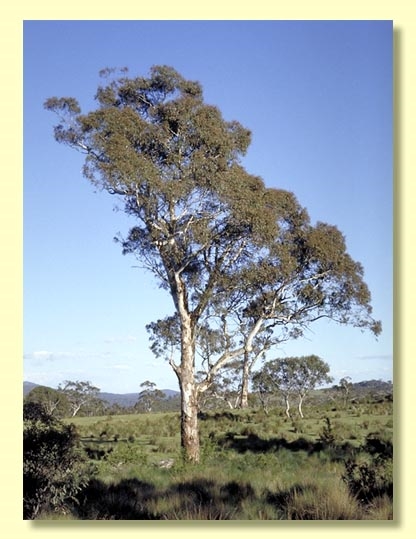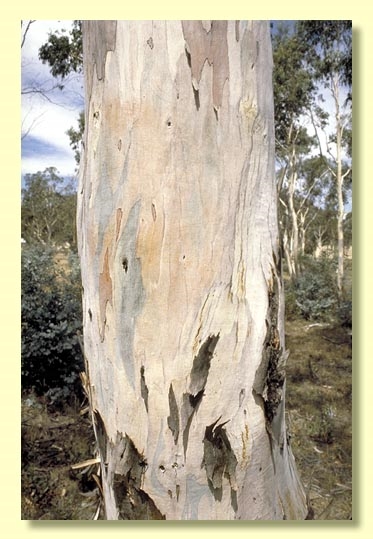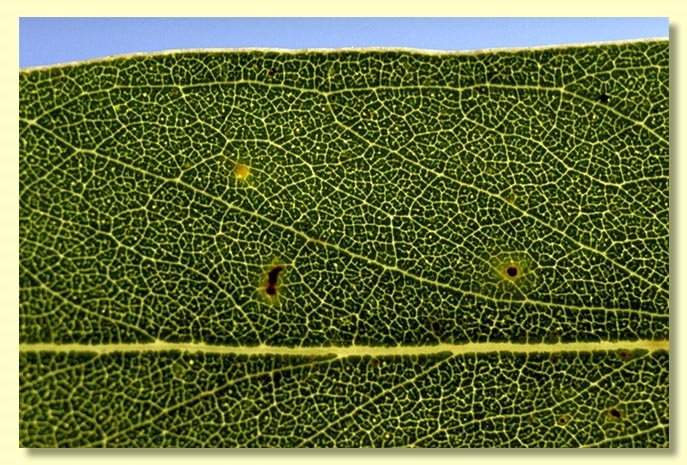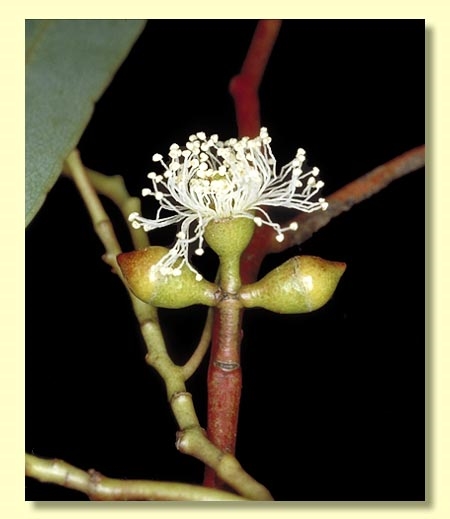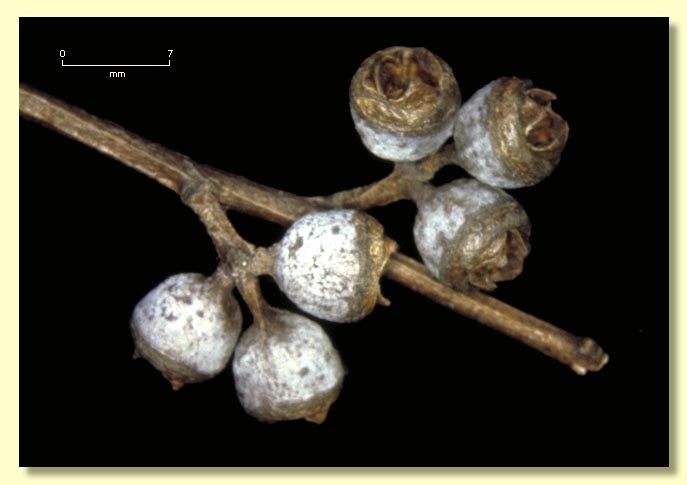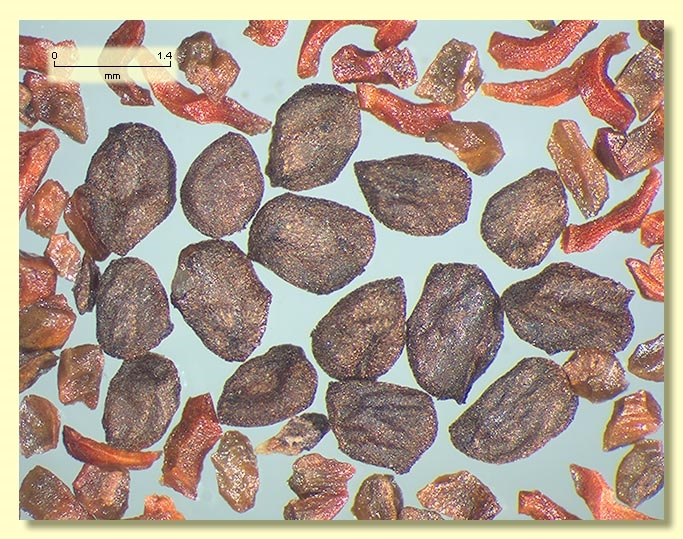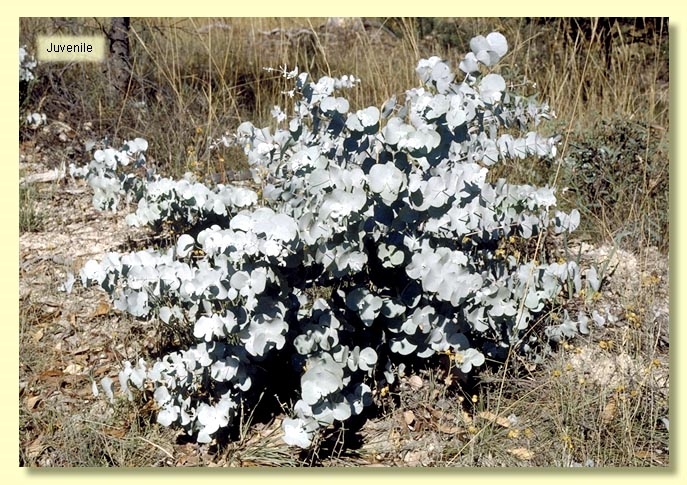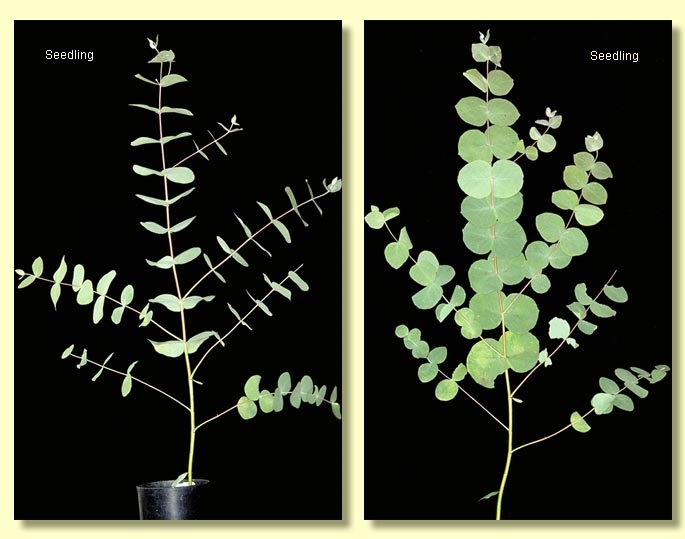Euclid - Online edition
Eucalyptus rubida subsp. rubida
Eucalyptus | Symphyomyrtus | Maidenaria | Euryotae | Viminales | Circulares
Eucalyptus gunnii var. rubida (H.Deane & Maiden) Maiden, Proc. Linn. Soc. New South Wales 26: 561, 562, 577 (1902). T: Jindabyne, NSW, Jan. 1898, J.H.Maiden s.n.; lecto: NSW, fide J.H.Maiden, Crit. Revis. Eucalyptus 3; 123 (1916).
Eucalyptus rubida subsp. septemflora L.A.S.Johnson & K.D.Hill, Telopea 4: 241 (1991). T: Victoria: 3 km N of Mt Beauty North on Wodonga road, 20 Feb. 1986, K.D.Hill & L.A.S.Johnson; holo: NSW.
Tree to 20 m tall. Forming a lignotuber.
Bark smooth throughout or with some patches of persistent rough, greyish bark at the base; smooth bark often powdery, white, cream, pale grey or pink, with horizontal black scars, usually with ribbons of decorticated bark in the upper branches; branchlets glaucous or non-glaucous.
Juvenile growth (coppice or field seedlings to 50 cm): stem rounded in cross-section, glaucous; juvenile leaves opposite and sessile for many nodes, orbicular, 2–6 cm long, 2.5–6.5 cm wide, bases rounded, truncate or amplexicaul, margin entire or crenulate, glaucous.
Adult leaves alternate, petiole 1–3.5 cm long; blade lanceolate to falcate, (6.8)8–17.5 cm long, 0.8–3.4 cm wide, base tapering to petiole, concolorous, glossy or dull, green, grey-green or glaucous, side-veins greater than 45° to midrib, densely to very densely reticulate, intramarginal vein parallel to and just within margin, oil glands usually obscure or with a few island or intersectional.
Inflorescence axillary unbranched, peduncles 0.3–0.8 cm long, buds 3 per umbel, sessile or on pedicels to 0.4 cm long. Mature buds ovoid to fusiform, 0.5–0.9 cm long, 0.3–0.5 cm wide, green, or yellow or slightly glaucous, scar present, operculum conical to rounded, stamens irregularly flexed or inflexed, anthers cuboid to cuneate, versatile, dorsifixed, dehiscing by longitudinal slits (non-confluent), style long, stigma blunt, locules 3 or 4, the placentae each with 4 vertical ovule rows. Flowers white.
Fruit sessile or on pedicels to 0.3 cm long, cup-shaped, hemispherical or campanulate, 0.3–0.6 cm long, 0.4–0.8 cm wide, glaucous or non-glaucous, disc raised-convex or oblique, valves 3 or 4, exserted or near rim level.
Seeds black, brown or grey, 1.5–2.5 mm long, ovoid or flattened-ovoid, often pointed at one end, usually lacunose, dorsal surface smooth or shallowly pitted, hilum ventral.
Cultivated seedlings (measured at ca node 10): cotyledons bilobed; stems rounded in cross-section, usually glaucous; leaves opposite and sessile for many nodes, cordate to orbicular, 2.2–4.5 cm long, 3.5–7 cm wide, amplexicaul or base truncate to rounded, margin entire, apex rounded to emarginate or sometimes pointed, dull, usually glaucous.
Flowering has been recorded in January, March, April, July, October and December.
There are two subspecies:
E. rubida subsp. rubida
This subspecies grows on hills, tablelands and mountain slopes of eastern Tasmania, in Victoria from Halls Gap east to Mt Delegate and usually on the northern side of the Divide, and throughout the Southern Tablelands of New South Wales. It has smooth bark. Trees of subsp. rubida in the Kiewa area of north-eastern Victoria occasionally have seven-flowered umbels and have been given the name E. rubida subsp. septemflora, which is not recognized in EUCLID as significantly different.
E. rubida subsp. barbigerorum
This species occurs to the north-west of Armidale on the Northern Tablelands of New South Wales. It is characterised by the rough black bark on the base of the tree.
Eucalyptus rubida belongs in Eucalyptus subgenus Symphyomyrtus section Maidenaria, a large group of species more or less restricted to south-eastern Australia, characterised by bilobed cotyledons, simple axillary inflorescences, buds with two opercula, stamens with versatile anthers and flattened seeds with a ventral hilum. Within this section, E. rubida belongs in series Viminales subseries Circulares, having buds in threes, fruit with an ascending disc and exserted valves, and glaucous, sessile, orbicular juvenile leaves opposite for many pairs.
Eucalyptus rubida subsp. barbigerorum is listed as "Vulnerable" under the Australian Government Environment Protection and Biodiversity Conservation Act 1999 (EPBC Act). Further information may be found at this web address:
http://www.environment.gov.au/cgi-bin/sprat/public/sprat.pl

